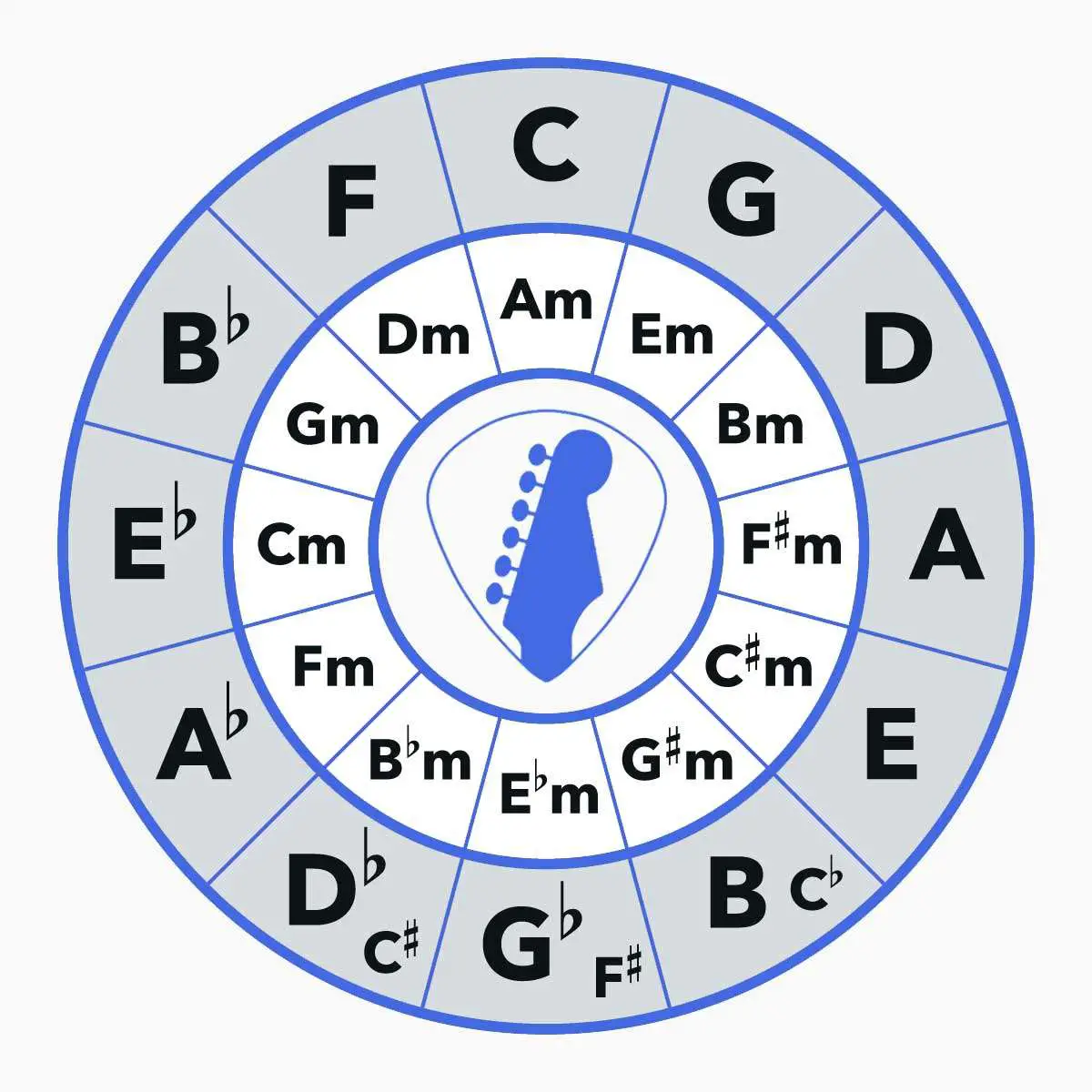The circle of fifths is a visual representation of how notes, keys, and chords are related to each other. While there are many primary uses for the Circle of Fifths, today we will be focusing on building Circle of Fifths Chord Progressions.

How To Read The Circle of Fifths
The Circle of fifths is an invaluable tool for musical artists because of its versatility. This is because the musical alphabet, as shown on the circle of fifths, can be thought of as notes, chords, or keys.
The circle of fifths can be used for:
- Visualizing key and chord relationships
- Building chords
- Building chord progressions
- Learning your key signatures
- Modulation
- Transposition
- Analysis
- Songwriting and composing
- Cheating on your music theory final
The outer circle contains the major keys. If we begin on C at the top of the circle, and make our way clockwise, we can see that each successive note is a P5 away from the former. If you went all the way around the circle, eventually you would end up on C major once again.
Similarly, we can begin on C and make our way counter clockwise, moving up in perfect fourths.
The inner circle works similarly, except it shows the minor keys.
Key Relationships
The circle of fifths also helps us to understand key relationships. Key relationships are important because they help us make more informed decisions on which chords and keys sound good together, and which we want to avoid.
Major and minor keys that share the same key signature are called relative keys. An example of this would be C major and A minor. Modulating between relative keys is a good idea!
Keys that have the same tonic, but have different key signatures, such as C major and C minor, are called parallel keys. Modulating between parallel keys is another common musical strategy!
The interval of a 5th is considered “closely related” meaning these chords sound great together. Closely related means that they have only one accidental difference, and this makes modulation, or switching between keys, sound seamless to the ear!
For example, the key of C is considered closely related to the keys of G and F major, since they are right next to each other. Similarly, The key of C is also closely related to the keys of A minor, E minor, and D minor, since they are all within one accidental difference in the key signature.
Keys that are enharmonically equivalent, such as Gb and F# are called enharmonic keys. These are spelled differently, but are played and sound exactly the same!
Now, we are left with keys that have no relationship with each other. Those are called foreign keys. An example of foreign keys would be C major to F# major.
Not only are these keys on different sides of the circle, but they have nearly no notes in common! Modulating between these keys would be frowned upon in most musical contexts, however I won’t stop you from trying it, especially if you create experimental music.

Circle of Fourths
A common source of confusion for many is when the Circle of Fifths is called the Circle of Fourths. Some parties prefer the name “Circle of Fourths” and while both names are generally accepted, “circle of fifths” is more widely used.
Truth be told, both names are correct, because a perfect fifth inverted is a perfect 4th. In other words, C to G is a perfect fifth, but G to C is a perfect 4th. Get it?
Your preference might also depend on the instrument you play. Guitarists and some woodwinds have a bias toward using sharp keys. Bassists and brass players have a bias towards flat keys, so naturally they might refer to it as a circle of fourths. Debating it is pointless, as both are correct.
Related: Major Chord Progressions
Building Chord Progressions Using The Circle Of Fifths
Circle of fifths patterns are predictable, and sound great. A predictable progression is a useful technique, especially for writing hit singles.
Providing your audience with a sense of comfort and stability provides a necessary backbone for expressing your true nature. Musical predictability is not always a bad thing, especially since your melody, lyrical content, and artistic vision combine to make a song novel.
On the other hand, overusing a circle of fifths progression may dilute your sense of tonality. This is because the movement of a fifth has such a final sound to it, but when you only move by a fifth, it makes it difficult for the ear to discern where the tonic is.
Anyways, to build a Circle of Fifths Chord Progression, we first need to pick a key. Let’s pick a C major. (Surprise, surprise!) Next, we must think about what chords are in C major. That’s easy!
C major, D minor, E minor, F major, G major, A minor, B diminished.
Great! The 3rd step is to use the chords in a key of C and move up a fifth (or down a 4th) , starting on the tonic. A circle of fifths progression in the key of C would look like this…
C major, F major, Bdim, E minor, A minor, D minor, G7, and back to C major.
In A minor, it would look like this:
A minor, D minor, G, C major, F major, B dim, E minor, back to A.
Related: Minor Chord Progressions
Songs That Use Circle Of Fifths Progressions
Cat Stevens – Wild World
Bach – Brandenburg Concerto No 2. In F major
Here Comes The Sun- The Beatles
Hey Joe- Jimmi Hendrix
Killing Me Softly – Roberta Flack
Awaken Yes
Frequently Asked Questions
What is the chord progression using the circle of fifths?
It’s called the Circle of Fifths Progression!
What is the 1 3 5 chord rule?
The 1 3 5 rule, refers to the pattern of root, 3rd, 5th used to build triads.
What is the 1 5 6 4 progression called?
The 1 5 6 4 progression is called the doo wop progression, the Stand By Me progression, or the 50’s progression. It is very common in oldies music.
What is the trick for the circle of fifths?
There are no tricks. The real trick is to learn it so you don’t need to look at it anymore! The best advice I can give you is to learn the 5th of every chord, as well as the 4th of every chord. This will make using the circle of fifths progression a lot easier for you.
Related: Major and Minor Chord Progressions Chart
Conclusion
The Circle of Fifths stands as a powerful tool that enriches the understanding and creativity of musicians across various aspects of music theory.
When crafting chord progressions using the Circle of Fifths, its predictability proves to be an asset for creating comforting and stable musical structures. However, excessive use of this pattern could blur tonality, emphasizing the importance of balance and contrast in composition.
The Circle of Fifths is not merely a theoretical concept but an essential asset for musicians. Its ability to weave together notes, keys, and chords fosters artistic expression and empowers musicians to create captivating and harmonically rich compositions.
